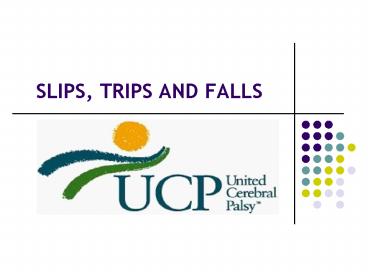SLIPS, TRIPS AND FALLS - PowerPoint PPT Presentation
1 / 16
Title:
SLIPS, TRIPS AND FALLS
Description:
CONDITIONS FOR STFs ... Conditions and situations that set the state for slips and falls are: Poor housekeeping; ... of hazardous conditions or surroundings. ... – PowerPoint PPT presentation
Number of Views:110
Avg rating:3.0/5.0
Title: SLIPS, TRIPS AND FALLS
1
SLIPS, TRIPS AND FALLS
2
OVERVIEW
- Types of Falls
- Characteristics of Falls
- Housekeeping
- Individual Behavior
- Stairs
- Slips, Trips and Falls in the Office Setting
3
DID YOU KNOW?
- Estimates say that 15-20 of all workers comp
costs are due to slips, trips and falls - This is not surprising when you consider that the
back is the most frequently injured body part in
a fall. - The average back injury ranges from 7000-25,000
in direct costs, whereby indirect costs typically
double this amount.
4
TYPES OF FALLS
- Two basic types of falls
- Same-level falls occur most often with lower
back sprain and/or strain and hamstring strain - In these types of falls, the person is injured
when he or she hits the walking or working
surface or strikes an object during the fall. - Elevated Falls typically more severe resulting
in fractured bones and occasionally death - Examples include falls from ladders, from
vehicles and equipment, from loading docks and
falls on stairs
5
CONDITIONS FOR STFs
- In general, slips and trips occur due to loss of
traction between the shoe and the walking surface
or an inadvertent contact with a fixed or
immovable object. Conditions and situations that
set the state for slips and falls are - Poor housekeeping
- Wet or slippery surfaces
- Obstacles in walkways
- Poor lighting
- Footwear and
- Individual behavior.
6
HOUSEKEEPING
- Good housekeeping is paramount.
- Good housekeeping includes picking up, wiping up
and cleaning up. - It includes the prompt removal of scrap and
waste. - Housekeeping is everyones responsibility.
7
INDIVIDUAL BEHAVIOR
- Inattention can be identifed as the root cause of
injury in most every category of accident
analysis. - Take this Inattention Test. Do you
- Get bored easily?
- Lose track of conversations (having to ask, What
were you saying?)? - Suddenly return to reality (after driving past
your exit on the freeway)? - Know your job so well you could do it with my
eyes closed? - Daydream?
8
INDIVIDUAL BEHAVIOR
- These examples would show potential for
inattention. - A persons state of mind is his/her own personal
property and, of course, cannot be controlled by
a boss or the workplace. - By not staying alert, individuals lose sight of
what they are doing and are not aware of
hazardous conditions or surroundings.
9
STAY ALERT!
- In order to avoid the pitfalls inattention plays
in STF injuries, perform these mental wake-up
exercises. - Concentrate on ways to do your job better, or
safer, or more efficiently. - Take micro-breaks by standing, flexing, or
stretching to stimulate the mind and body. - Pause and evaluate what has just occurred and
review what is about to happen. - Remain focused on your hand and foot positions.
- Check your balance and surroundings.
- Remind yourself what the costs of inattention
could be.
10
ELEVATED FALLS
- Falls from elevated surfaces are generally less
frequent, but usually more severe than same-level
falls. Some items usually involved in elevated
falls include - Uneven surfaces
- Stairs
- Ladders
- Docks/ramps
- Powered industrial lifts
11
UNEVEN SURFACES
- A majority of elevated falls occur on walking and
working surces that are not necessarily of any
significant height. - For example, a number of injuries have been
reported involving stepping off the edge of a
curb or sidewalk to stepping into animal holes.
12
STAIRS
- Falls are the second leading cause of accidental
deaths in the U.S. Of these fatal falls, nearly
half occur on steps and stairways. - To prevent a stairway fall, awareness and
prevention remain the keys. - Before setting foot on a stairway, the following
preventative measures should be physically in
place or consciously in your mind - Whether goin up or down stairs, always use the
handrail. - Seeing where you are going is important. Msake
sure the stairs are well lit with on/off switches
at the top and bottom of the stairwell. - Make sure the stairs are clear and free of all
obstacles.
13
STFs IN THE OFFICE
- Slips major causes are wet surfaces, occasional
spills, or weather hazards - Always clean up spills immediately or mark the
wet areas so others can see the spill - Trips common reasons for these are when view is
obstructed, you take short cuts or there is
clutter in or near the walkway - Walkways must be kept free of objects and
clutter. - Remember to close file drawers after each use.
- Be aware of thresholds.
- Never carry a load that obstructs your vision.
14
STFs IN THE OFFICE
- Falls most commonly caused by improper use of
ladders - Make sure you never use a chair or table as a
step ladder to reach high places. - When using a ladder, follow all safety tips.
- When using the stairs, always take one step at a
time and make sure your foot is firmly planted
before shifting your weight. - Always use the handrails, and never jump from one
level to the next.
15
REMEMBER
- You can be extremely careful for years only to
get hurt in two seconds of inattentino,
distraction, or hurrying to get the job done. - Instruction, training and constant reminders can
only go so far. - It is ultimately up to each individual to
- Plan
- Stay alert, and
- PAY ATTENTION!
16
ANY QUESTIONS?































